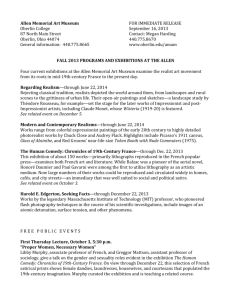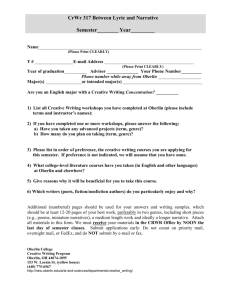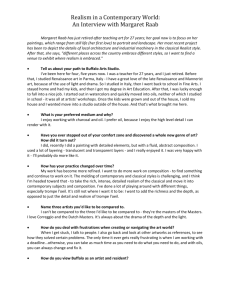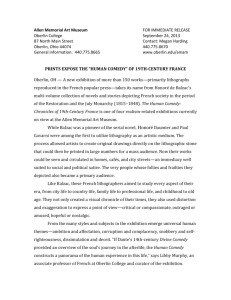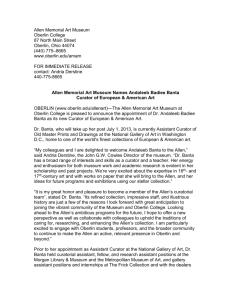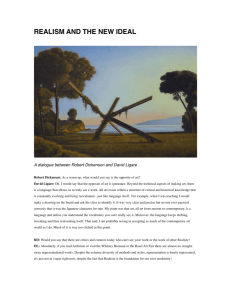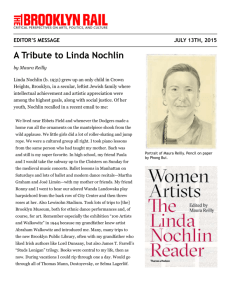Realism Themed Exhibitions Open at Oberlin`s Art
advertisement
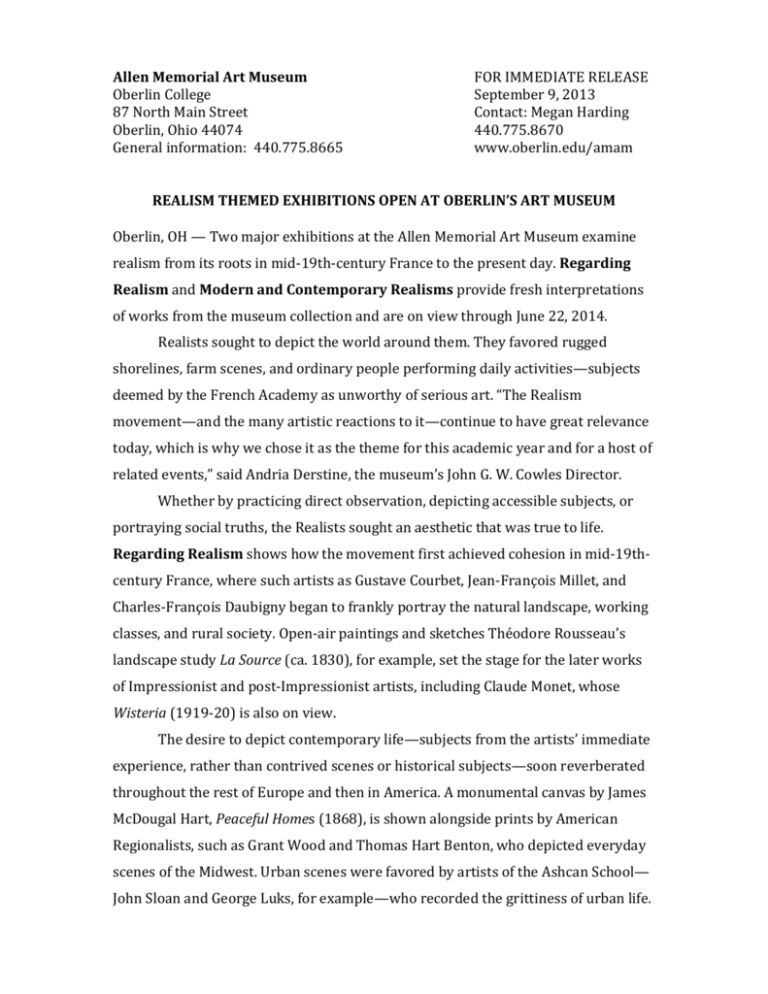
Allen Memorial Art Museum Oberlin College 87 North Main Street Oberlin, Ohio 44074 General information: 440.775.8665 FOR IMMEDIATE RELEASE September 9, 2013 Contact: Megan Harding 440.775.8670 www.oberlin.edu/amam REALISM THEMED EXHIBITIONS OPEN AT OBERLIN’S ART MUSEUM Oberlin, OH — Two major exhibitions at the Allen Memorial Art Museum examine realism from its roots in mid-19th-century France to the present day. Regarding Realism and Modern and Contemporary Realisms provide fresh interpretations of works from the museum collection and are on view through June 22, 2014. Realists sought to depict the world around them. They favored rugged shorelines, farm scenes, and ordinary people performing daily activities—subjects deemed by the French Academy as unworthy of serious art. “The Realism movement—and the many artistic reactions to it—continue to have great relevance today, which is why we chose it as the theme for this academic year and for a host of related events,” said Andria Derstine, the museum’s John G. W. Cowles Director. Whether by practicing direct observation, depicting accessible subjects, or portraying social truths, the Realists sought an aesthetic that was true to life. Regarding Realism shows how the movement first achieved cohesion in mid-19thcentury France, where such artists as Gustave Courbet, Jean-François Millet, and Charles-François Daubigny began to frankly portray the natural landscape, working classes, and rural society. Open-air paintings and sketches Théodore Rousseau’s landscape study La Source (ca. 1830), for example, set the stage for the later works of Impressionist and post-Impressionist artists, including Claude Monet, whose Wisteria (1919-20) is also on view. The desire to depict contemporary life—subjects from the artists’ immediate experience, rather than contrived scenes or historical subjects—soon reverberated throughout the rest of Europe and then in America. A monumental canvas by James McDougal Hart, Peaceful Homes (1868), is shown alongside prints by American Regionalists, such as Grant Wood and Thomas Hart Benton, who depicted everyday scenes of the Midwest. Urban scenes were favored by artists of the Ashcan School— John Sloan and George Luks, for example—who recorded the grittiness of urban life. Regarding Realism was organized by Curatorial Assistant Sara Green, a 2012 graduate of Oberlin College, with assistance from Assistant Curator of Modern and Contemporary Art Denise Birkhofer. The works in Modern and Contemporary Realisms range from colorful Expressionist paintings of the early 20th century to highly detailed Photorealist works by Chuck Close and Audrey Flack. “The artists are not concerned with creating truthful representations of actual people, places, or objects, but rather filter their subjects through their own particular style or aesthetic,” said Assistant Curator of Modern and Contemporary Art Denise Birkhofer, who organized the exhibition. Highlights include Picasso’s 1911 canvas, Glass of Absinthe, a Cubist work that retains a recognizable still-life subject, along with two paintings by Marc Chagall that offer dream-like compositions. Works in the Pop Art category include Andy Warhol’s silkscreened Jackie (1963), Claes Oldenburg’s 13-foot Giant Saw (1966), and Red Grooms’ near-life-size Token Booth with Nude Commuters (1975). Also featured is a section of works in the Socialist Realism genre—primarily propagandistic works from China and the former Soviet Union—organized by Curator of Academic Programs Liliana Milkova. RELATED EVENT Thursday, December 5, 5:30 p.m. “Courbet’s Realism” — Lecture by Linda Nochlin Linda Nochlin, a leading scholar in the field of 19th-century art, holds the Lila Acheson Wallace Professorship in Modern Art at New York University’s Institute of Fine Arts. Nochlin’s 1971 book Realism remains the standard source for study of the art movement. She is known for her seminal essay “Why Have There Been No Great Women Artists?” and other publications such as Women, Art and Power, The Politics of Vision: Essays on 19th-Century Art and Society, and Representing Women. For complete event listings, please visit www.oberlin.edu/amam. ### HOURS: Tuesday through Saturday, 10 a.m. to 5 p.m.; Sunday 1 to 5 p.m.; closed Mondays and major holidays. Free educational or group guided tours may be arranged by calling 440.775.8671. The Allen Memorial Art Museum cares for more than 14,000 works that provide a comprehensive overview of the history of art. We work with Oberlin College faculty and students to promote direct study of original works of art, foster visual literacy, and deepen appreciation for the diversity of world culture. Founded in 1917 with the idea that learning about art is important for everyone, the museum offers free admission.
